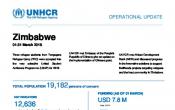Zimbabwe
Operation: Zimbabwe
Location
{"longitude":29,"latitude":-19,"zoom_level":0,"iso_codes":"'ZWE'"}
By clicking on the icons on the map, additional information is displayed.
Key Figures
| 2017 year-end results | |
| 100% | people of concern had access to primary, secondary and tertiary health care |
| 790 | latrines were constructed |
| 780 | people of concern received production kits or inputs for agriculture/ livestock activities |
| 150 | people of concern had access to anti-retroviral treatment |
| 2018 planning figures | |
| 100% | of households will have their basic and domestic item needs met |
| 100% | of primary school–aged children will be enrolled in primary education |
| 100% | of women will be provided with sanitary supplies |
| 35% | of households will have access to arable land or other productive natural resources |
| 40 | government staff will be trained on statelessness |
People of Concern
97%
Decrease in
2016
2016
| 2016 | 10,064 |
| 2015 | 310,624 |
| 2014 | 9,225 |

[["Refugees",7426],["Asylum-seekers",952],["Returned refugees",6],["Others of concern",1680]]
Loading ...
Zimbabwe
< Back
2017
{"categories":[2013,2014,2015,2016,2017,2018],"budget":[7.45939881,6.82514325,5.80670135,6.43412162,10.95797928,7.81785047],"expenditure":[5.3211349,5.11835744,4.82715146,4.95217574,7.07456308,null]}
{"categories":[2013,2014,2015,2016,2017,2018],"p1":[5.26126792,6.13458825,5.67679147,6.08461144,10.52588522,7.56402247],"p2":[0.37122646,null,0.12990988,0.34951018,0.43209406,0.253828],"p3":[null,null,null,null,null,null],"p4":[1.82690443,0.690555,null,null,null,null]}
{"categories":[2013,2014,2015,2016,2017,2018],"p1":[4.64729118,4.77045832,4.7047107,4.75229399,6.83835733,null],"p2":[null,null,0.12244076,0.19988175,0.23620575,null],"p3":[null,null,null,null,null,null],"p4":[0.67384372,0.34789912,null,null,null,null]}
Loading ...
CHOOSE A YEAR
- 2015
- 2016
- 2017
- 2018
Operational context
The overall situation remained stable and Zimbabwe continued to maintain a favourable protection environment. Due to the arrival of Mozambican asylum-seekers, and the increase in arrivals from the Democratic Republic of Congo (DRC), Zimbabwe had an overall increase of nearly 50 per cent in people of concern to UNHCR during 2017, resulting in additional needs in Tongogara refugee camp.Population trends
As of end of 2017, Zimbabwe hosted over 18,800 people of concern, mainly in Tongogara refugee camp. Over 70 per cent of refugees and asylum-seekers originated from the DRC.Key achievements
- In coordination with the Government and partners, UNHCR provided lifesaving protection and humanitarian assistance to people of concern, including shelter, health, sanitation and core relief items to Mozambican asylum-seekers hosted in Tongogara refugee camp;
- The Government of Zimbabwe, with UNHCR’s support, produced 1,000 machine-readable travel documents.
- The refugee status recognition rate in Zimbabwe stood at 88 per cent.
Unmet needs
- Insufficient resources limited UNHCR’s support for advanced level of secondary education in Tongogara refugee camp. Shortage of qualified teachers and infrastructure continued to pose a challenge.
- There is need to increase the number of Blair Ventilated Improved Pit latrines to match the increase in population.
- In order to increase the water supply in Tongogara refugee camp, more water lines, taps and storage need to be constructed and installed.
- Shortages of medicines in government referral institutions has negatively affected access to health assistance for POCs due to the operation’s inability to procure drugs from private pharmacies as result of limited resources.
Working environment
The number of Mozambicans fleeing insecurity to neighbouring countries, including Zimbabwe, may increase during 2017. It is estimated that a sizeable number of stateless people reside in Zimbabwe.Despite experiencing economic challenges, the overall situation in Zimbabwe remains relatively calm, although severely impacted by heightened intra-party political tensions. The country continues to be committed to adhering to international norms and standards, and works in cooperation with humanitarian organizations.
The Government maintains asylum space in rural and urban settings, and refugees have access to national education and health systems. The Registrar General’s Office has agreed to print and issue Machine-Readable Convention Travel Documents to refugees, if necessary funding is identified. Refugee farmers also have access to arable land in Tongogara camp to supplement their diets and improve their livelihoods.
Key Priorities
In 2017 the UNHCR operation in Zimbabwe will focus on:• strengthening the asylum regime and enhance the capacity of the Zimbabwe Refugee Committee on refugee status determination;
• providing appropriate durable solutions through targeted interventions;
• obtaining improved documentation for people of concern;
• improving mechanisms and procedures to identify people in need of international protection through border monitoring and regular visits to detention facilities;
• providing adequate support in livelihoods and self-reliance activities to reduce economical dependency.
